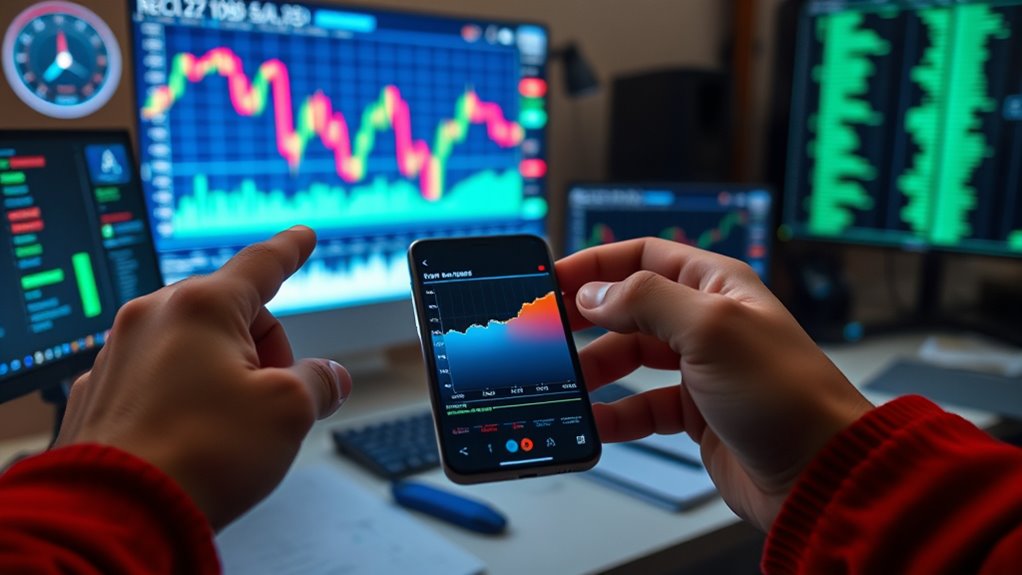The Fear & Greed Index shows market sentiment, helping you understand whether traders are overly confident or fearful. Extreme greed suggests prices may be inflated and near a top, while intense fear can indicate a potential buying opportunity or a market bottom. By paying attention to these signals, you can make more informed decisions and avoid emotional traps. If you want to learn how to interpret these signals better, there’s more to discover ahead.
Key Takeaways
- The index measures overall market sentiment, indicating whether traders are driven by fear or greed.
- Extreme greed suggests possible market tops and overconfidence among investors.
- Excessive fear signals potential buying opportunities due to widespread pessimism.
- The index helps identify emotional extremes that often precede market reversals or corrections.
- Using the index alongside other analysis tools enhances timing and decision-making in crypto trading.

The Fear & Greed Index is a popular tool that gauges market sentiment by analyzing various emotional indicators. As a crypto investor, understanding this index can give you valuable insights into the prevailing investor psychology that drives market movements. When the index signals extreme greed, it suggests that many traders are feeling overly confident, which often leads to inflated prices and potential market bubbles. Conversely, extreme fear indicates widespread anxiety and pessimism, which might present buying opportunities if you believe the market has overreacted.
By paying attention to the Fear & Greed Index, you get a clearer picture of how collective emotions influence crypto prices. Market sentiment isn’t just about numbers; it reflects the mood of traders and investors, shaping buying and selling decisions that amplify price swings. When the index shows high greed levels, you might consider caution, as the market could be nearing a top. On the other hand, when fear dominates, it could be a sign that panic selling has pushed prices down too far, creating a potential entry point for savvy investors.
This index fundamentally distills complex investor psychology into a simple, easy-to-understand metric. It pulls data from multiple sources, such as market volatility, trading volume, social media sentiment, and surveys, to measure the emotional state of the market. Recognizing these signals helps you avoid impulsive decisions driven by short-term emotions. Instead, it encourages a more disciplined approach, aligning your strategies with the broader psychological landscape rather than just price charts. Additionally, understanding the market psychology behind these signals can help you better anticipate future movements.
It’s important to remember that the Fear & Greed Index isn’t a crystal ball. It doesn’t predict exact market turns but highlights emotional extremes that often precede reversals or consolidations. When the index hits levels of extreme greed, it may be a warning to take profits or tighten stops. Conversely, during periods of extreme fear, you might see a chance to buy undervalued assets before the crowd regains confidence. Using this index as part of your overall analysis allows you to better gauge when the market might be overextended or ripe for a bounce.
Frequently Asked Questions
How Often Is the Fear & Greed Index Updated?
You’ll find that the Fear & Greed Index updates daily, keeping you informed about market volatility and shifts in investor psychology. This frequent update helps you gauge whether the market is feeling overly fearful or greedy, guiding your decision-making. By monitoring these changes regularly, you can better understand sentiment trends and adjust your strategies accordingly, making it a valuable tool for staying ahead in the dynamic crypto landscape.
Can the Index Predict Future Market Crashes?
The Fear & Greed Index can’t reliably predict future market crashes, but it offers valuable insights into market psychology and investor behavior. Historically, extreme readings often signal turning points—like market tops or bottoms—yet aren’t foolproof. For example, when the index hits extreme fear, it’s often a sign investors are overly cautious, possibly indicating a buying opportunity. Stay cautious, but don’t rely solely on the index for predicting crashes.
How Does the Index Compare to Traditional Market Sentiment Indicators?
You’ll find the Fear & Greed Index offers a quick snapshot of market sentiment and investor psychology, but it’s less exhaustive than traditional indicators like moving averages or volume analysis. While it captures emotional extremes, it doesn’t account for fundamental factors. Use it alongside other tools to get a clearer picture, recognizing that it’s best for gauging current market moods rather than predicting long-term trends.
Is the Index Reliable for Short-Term Trading Decisions?
You can’t fully rely on the Fear & Greed Index for short-term trading because market volatility and investor psychology often shift rapidly. While it offers useful insights into overall sentiment, emotions can mislead you during sudden swings. Use it as a guide rather than a sole decision-maker. By understanding how market volatility influences investor psychology, you’ll make more balanced trades instead of reacting impulsively to fleeting signals.
What Factors Influence Changes in the Fear & Greed Index?
Changes in the Fear & Greed Index are mainly influenced by market volatility and investor psychology. When markets experience sharp swings or uncertainty, the index tends to shift as investors become more fearful or greedy. Positive news or bullish trends boost greed, while negative developments or crashes trigger fear. Your understanding of these factors helps you interpret the index’s movements, giving insights into current market sentiment and potential turning points.
Conclusion
By keeping an eye on the Fear & Greed Index, you can better gauge market sentiment and make smarter decisions. For instance, when the index hits extreme fear levels, history shows that buying opportunities often arise. Currently, the index stands at 25, indicating fear in the market. Remember, understanding these signals helps you navigate crypto volatility with confidence, turning emotional swings into strategic moves. Stay informed, and let the index guide your next move.









